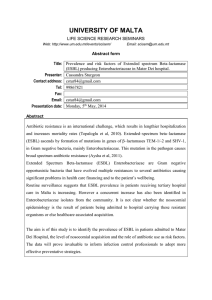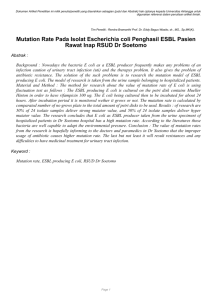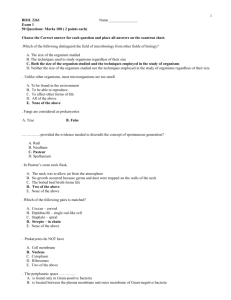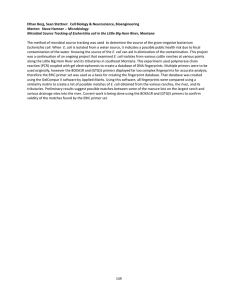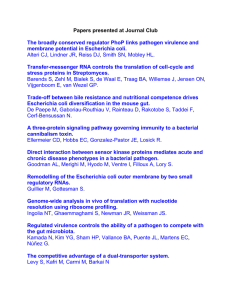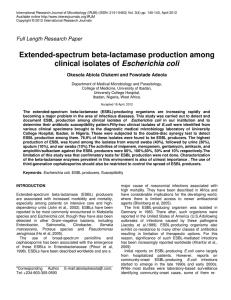Document 14104778
advertisement
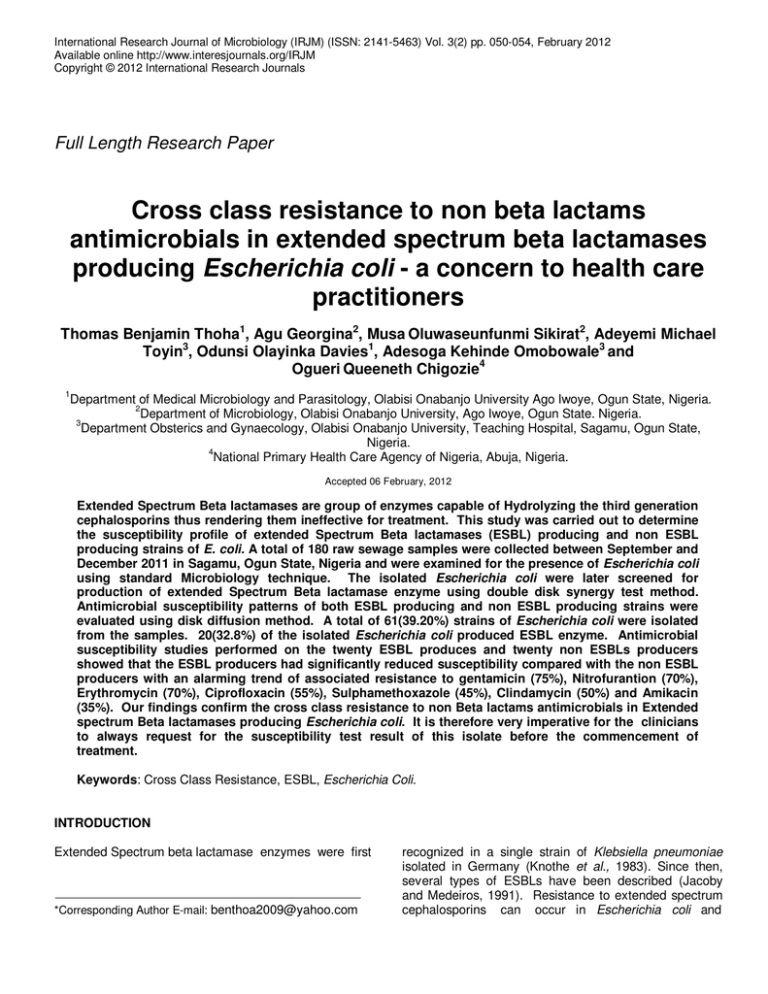
International Research Journal of Microbiology (IRJM) (ISSN: 2141-5463) Vol. 3(2) pp. 050-054, February 2012 Available online http://www.interesjournals.org/IRJM Copyright © 2012 International Research Journals Full Length Research Paper Cross class resistance to non beta lactams antimicrobials in extended spectrum beta lactamases producing Escherichia coli - a concern to health care practitioners Thomas Benjamin Thoha1, Agu Georgina2, Musa Oluwaseunfunmi Sikirat2, Adeyemi Michael Toyin3, Odunsi Olayinka Davies1, Adesoga Kehinde Omobowale3 and Ogueri Queeneth Chigozie4 1 Department of Medical Microbiology and Parasitology, Olabisi Onabanjo University Ago Iwoye, Ogun State, Nigeria. 2 Department of Microbiology, Olabisi Onabanjo University, Ago Iwoye, Ogun State. Nigeria. 3 Department Obsterics and Gynaecology, Olabisi Onabanjo University, Teaching Hospital, Sagamu, Ogun State, Nigeria. 4 National Primary Health Care Agency of Nigeria, Abuja, Nigeria. Accepted 06 February, 2012 Extended Spectrum Beta lactamases are group of enzymes capable of Hydrolyzing the third generation cephalosporins thus rendering them ineffective for treatment. This study was carried out to determine the susceptibility profile of extended Spectrum Beta lactamases (ESBL) producing and non ESBL producing strains of E. coli. A total of 180 raw sewage samples were collected between September and December 2011 in Sagamu, Ogun State, Nigeria and were examined for the presence of Escherichia coli using standard Microbiology technique. The isolated Escherichia coli were later screened for production of extended Spectrum Beta lactamase enzyme using double disk synergy test method. Antimicrobial susceptibility patterns of both ESBL producing and non ESBL producing strains were evaluated using disk diffusion method. A total of 61(39.20%) strains of Escherichia coli were isolated from the samples. 20(32.8%) of the isolated Escherichia coli produced ESBL enzyme. Antimicrobial susceptibility studies performed on the twenty ESBL produces and twenty non ESBLs producers showed that the ESBL producers had significantly reduced susceptibility compared with the non ESBL producers with an alarming trend of associated resistance to gentamicin (75%), Nitrofurantion (70%), Erythromycin (70%), Ciprofloxacin (55%), Sulphamethoxazole (45%), Clindamycin (50%) and Amikacin (35%). Our findings confirm the cross class resistance to non Beta lactams antimicrobials in Extended spectrum Beta lactamases producing Escherichia coli. It is therefore very imperative for the clinicians to always request for the susceptibility test result of this isolate before the commencement of treatment. Keywords: Cross Class Resistance, ESBL, Escherichia Coli. INTRODUCTION Extended Spectrum beta lactamase enzymes were first *Corresponding Author E-mail: benthoa2009@yahoo.com recognized in a single strain of Klebsiella pneumoniae isolated in Germany (Knothe et al., 1983). Since then, several types of ESBLs have been described (Jacoby and Medeiros, 1991). Resistance to extended spectrum cephalosporins can occur in Escherichia coli and Thoha et al. 051 Klebsiella pneumoniae via the production of extended spectrum Beta lactamases that are capable of hydrolyzing the oxyiminocephalo-sporins and monobactams (Bradford, 2004) thus making therapy very difficult for clinicians by rendering the antibiotic ineffective (Kim et al., 2002, Lin et al., 2004).These enzymes are encoded by plasmid genes and are often located within transponson and integrons thereby facilitating their association with other transferable genetic determinants of resistance to cotrimoxazole, aminoglycosides or tetracyclines among others (Lautenbach et al, 2001). These types of organism are important sources of nosocomial and community acquired infections (Borer et al., 2002.,Canton and Coque, 2006).Clinicians, Microbiologists, infection control practitioners and hospital epidemiologists are concerned about ESBL producing bacteria because of the increasing incidence of such infections, the limitations of effective antimicrobial drug therapy and adverse patient outcomes (Rossi et al., 2006).There has also been reports of the growing concern of the organisms producing extended spectrum beta lactamases showing cross class resistance to non Beta lactams Antimicrobials (Paterson, 2000., Procop et al., 2003).This confers additional resistance to other antimicrobial classes including fluoroquinolones and aminoglycosides, which may result in therapeutic failures and possibly life threatening bacterial infections (Hunter et al., 2010). This thus imply the reason why it is important to detect ESBL producing isolates for proper interpretation of susceptibility tests and subsequent antimicrobial therapy (Paterson et al.,2000., NCCLS 2001., Hadziyannis et al., 2000). This study was therefore designed to compare the frequency of resistance to non Beta lactam antibiotics in ESBL producing and non ESBL producing stains of Escherichia coli. Phenotypic determination of ESBL Enzymes This was carried out as described by Afiukwa et al. (2010) using double disc synergy test. Briefly, a sterile Mueller Hinton agar was prepared and a 0.5 MacFarland equivalent standard of the test organisms was streaked on the surface of the agar with a sterile loop and allowed for 15-20 minutes to prediffuse. An Augmentin which is a combination of Clavulanic acid (20µg) and amoxicillin (10µg) was placed at the centre of a petridish and cefotaxime (30µg), ceftaxidime (30µg), aztreonam (30µg), ciprofloxacin (30µg) were place 15mm apart centre to centre on the plates with a sterile forceps. These were incubated at 35°C for 18 – 24h.An enhanced zone of inhibition from 5mm above in the presence of Augmentin is regarded as positive for Phenotypic production of ESBL enzyme. Antibiotic Susceptibility Testing The medium used was Mueller Hinton Agar (Oxoid, U.K).The bacterial inoculum were adjusted to 0.5McFarland turbidimetric standard and inoculated onto the medium using flooding method. For each antibiotics, three replicate plates were prepared against the test organisms (ESBL producing E. coli and non ESBL producing E. coli). Antibiotic susceptibility of each antibiotic was evaluated by the agar disc diffusion method. The following antibiotic disc were used; Gentamicin (10µg), Erythromycin (5µg), Ciprofloxacin (5µg), Imipenem (10 µg), Amikacin (10 µg) Nitrofurantion (50 µg), Sulphamethoxazole (25µg), Clindamycin (20µg). These were incubated at 37°C for 24hour after which the interpretation of the zones of inhibition were done using CLSI (2000) interpretative charts as resistant,sensitive and intermediate. MATERIALS AND METHODS RESULTS Collection of Sewage water A total of 180 raw sewage were collected from different sources of the samples in and around Sagamu, Ogun State, Nigeria. 18 samples each of this raw sewage were collected from 10 different collection sites at different time for a period of 4months. Bacteriological analysis An MPN presumptive test in MacConkey broth, MPN confirmatory test in brilliant green bile lactose broth and complete test using EMB agar followed by biochemical tests were performed by isolation and confirmation of Esherichia coli (Cheesbrough, 2006). Out of 180 Sewage samples examined for the presence of Escherichia coli, 61(39.2%) showed the presence of the organisms. 20(32.8%) of the isolated Escherichia coli produced ESBL enzyme while the remaining 41(67.2%) were non ESBL producers. The susceptibility profiles of the ESBL producing and non ESBL producing strains of Escherichia coli determined shows that the ESBLs producers were significantly more resistant to the non Beta lactams antibiotics tested (P<0.05) (table 2). The association between Extended spectrum Beta lactamases enzyme and non Beta lactam antibiotics were statistically evaluated and this was foud to be significantly associated (X2c = 58.8, X2t = 3.84, P<0.05) (table 4) and this lead to the rejection of the null hypothesis which states that no association exist between beta lactamases 052 Int. Res. J. Microbiol. Table 1. Comparison of the susceptibility profiles of ESBL producing and non ESBL producing Escherichia coli Antibiotics Gentamicin Nitorfurantoin Erythromycin Ciprofloxacin Imipenem Amikacin Sulphamethoxazole Clindamycin ESBL Producers Susceptible Resistant N (%) N(%) 5(25%) 15(75%) 6(30%) 14(70%) 6(30%) 14(70%) 9(45%) 11(55%) 20(100%) -------13(65%) 7(35%) 11(55%) 9(45%) 10(50%) 10(50%) Non ESBL Producers Susceptible Resistant N (%) N(%) 19(95%) 1(5%) 19(95%) 1(5%) 17(85%) 3(15%) 14(70%) 6(30%) 20(100%) ------19(95%) 1(5%) 17(85%) 3(15%) 18(90%) 2(10%) N = Number of isolates, % = Percentage of isolates Table 2. Relative Evaluation of the significancy of the resistance pattern of ESBL and Non ESBL Producers to Non Betalactam Antibiotics. Antibiotics Gentamicin Nitorfurantoin Erythromycin Ciprofloxacin Imipenem Amikacin Sulphamethoxazole Clindamycin ESBL Producers Non ESBL Producers Mean of ± SEM of the resistance isolates resistance isolates 15.00 ± 0.00 1.00 ± 0.00 14.00 ± 0.00 1.00 ± 0.00 14.00 ± 0.00 3.00 ± 1.41 11.00 ± 0.00 6.00 ± 1.41 --------------7.00 ± 1.00 1.00 ± 0.00 9.00 ± 1.41 3.00 ± 0.00 10.00 ± 0.00 2.00 ± 0.71 t – value P value 93.0 86.3 11.0 5.0 -----6.0 6.0 16.0 <0.05 <0.05 <0.05 <0.05 ------<0.05 <0.05 <0.05 t – value P value -14 -9.9 -8.5 -5.0 0.0 -6.0 -6.0 -8.0 <0.05 <0.05 <0.05 <0.05 >0.05 <0.05 <0.05 <0.05 Table 3. Sensitivity Pattern of ESBL and Non ESBL Producers to Non Beta lactam Antibiotics Antibiotics Gentamicin Nitorfurantoin Erythromycin Ciprofloxacin Imipenem Amikacin Sulphamethoxazole Clindamycin ESBL Producers Non ESBL Producers Mean of ± SEM of the resistance isolates resistance isolates 5.00 ± 0.00 19.00 ± 1.00 5.00 ± 1.00 19.00 ± 1.00 5.00 ± 0.00 17.00 ± 1.00 9.00 ± 0.00 14.00 ± 1.00 20.00 ± 0.00 20.00 ± 1.00 13.00 ± 0.00 19.00 ± 1.00 11.00 ± 1.00 17.00 ± 0.00 10.00 ± 0.00 18.00 ± 1.00 Table 4. Association between Extended spectrum Beta lactamase and Antibiotic resistance Beta lactamase reaction Antibiotic Sensitivity test result Sensitive Resistant 80 80 143 17 223 97 Positive Negative Total 2 X c = 58.8, 2 2 2 X t = 3.84, X c > X t hence null hypothesis was rejected. Total 160 160 320 Thoha et al. 053 2 enzyme and non Beta lactam antibiotic resistance. X c is 2 the chi square calculated and X t is the chi square tabulated. DISCUSSION Over the past decade, ESBL producing organisms have emerged as serious nosocomial pathogens throughout the world (Livermore and Yuan, 1996). Outbreaks due to this type of pathogen among the most critically ill patients in intensive care units has been reported (Jacoby,1997).Continued mismanaged selective pressure however contributed towards the emergence of multiple drug resistance bacteria and that has been regarded as an inevitable genetic response to misappropriated exposures of microbial populations to antimicrobial therapy (Sheikh et al., 2003).The high detection rate of Escherichia coli in fecal samples was expected because these samples provide an excellent growth condition for these bacterial (Oshoma et al., 2009).This study disclosed an elevated decreased susceptibility of ESBL producing Escherichia coli to all the tested antibiotics (Procop et al.,2003; Paterson et al., 2000a, Paterson et al.,2000b).The decreased susceptibility of ESBL producing Escherichia coli to the tested antibiotics may be due to the multidrug resistance gene in plasmids that they are harbouring (Rooney et al., 2009).However,the non ESBL producing Escherichia coli were significantly susceptible to the various antibiotics tested. This may be due to the lack of mutation that has occurred in the active serine site of ESBL producing organisms (Afiukwa et al.,2010).Results showed that all the twenty extended spectrum Beta lactamase producing Escherichia coli isolates were found to be multidrug resistant. Antibiotic resistance among isolates of Escherichia coli in the present study was comparable to reports from other parts of the world,which also revealed multiple drug resistance among gram negative rods (Oplustil et al., 2001.,Winokur et al.,2001., Afiukwa et al., 2010). Antibiotic susceptibility test results of the above isolates also revealed an alarming trend of associated resistance to gentamicin (75%), Nitrofurantoin (70%), Erythromycin (70%), Ciprofloxacin (55%), Sulphamethoxazole (45%), Clondamycin (50%), Amikacin (35%).Such resistance has been reported in recent surveys from Canada, Italy, Spain, Greece and UK and are due to the blaCTX-M genes that are found in association with genetic structures such as sul 1 type integron (Padmini et al., 2008). This structures is genetically linked to class 1 integrons known to integrate antibiotic-resistant gene cassette responsible for resistance to B-lactams, aminoglycosides, chlorampheniol, sulphonamids and to a lesser exlentvifampicin (Pitout et al., 2005). In the present study, we demonstrated significant differences in the susceptibility profiles between ESBL producing and Non ESBL producing E.coli for gentamicin, Nitrofurantion, Erythromycin, Ciprofloxacin, Amikacin, Sulphamethoxazole and clindamycin except for Imipenem where no significant difference was observed in the susceptibility patterns of both organisms. These finding supports the hypothesis that ESBL producing strains of Escherichia coli are more likely to have diminished susceptibility to non B – lactam antibiotics compared with non ESBL producing isolates of Escherichia coli. Our finding is also similar to that of Procop et al. (2003).Therefore, it is imperative to use the antimicrobial susceptibility profile of the individual isolates to guide treatment. REFERENCES Afiukwa FN, Iroha IR, Afiukwa CA, Ayogu TE, Oji AE, Onwa NC (2010). Presence of coliform producing extended spectrum beta lactamase in sachet-water manufactured and sold in Abakaliki, Ebonyi State, Nigeria. Int. Res. J. Microb. 1(2):32-36. Borer A, Gilad J, Menashe G, Peled N, Riesenberg K, Schlaeffer F(2002). Extended spectrum beta-lactamase-producing Enterobacteriaceae strains in community-acquired bacteremia in southern Israel. Med. Sci. Monit.8:44-46 Bradford PA (2004). Extended-spectrum β-lactamases in the 21st century: characterization, epidemiology, and detection of this important resistance threat. Clin Microbiol Rev.48: 933-51 Canton R, Coque TM (2006). The CTX-M b-lactamase pandemic. Curr. Opin Microbiol. 9:466-475. Cheesborough M (2002). District Laboratory practice in tropical nd countries Part two,2 edition.Cambridge univ.Press,UK.PP143-180. Hadziyannis E, Tuohy M, Thomas L (2000).Screening and confirmatory testing for extended spectrum β-lactamases (ESBL) in Escherichia coli, Klebsiella pneumoniae, and Klebsiella oxytoca clinical isolates. Diagn. Microbiol. Infect. Dis.36:113-117. Hunter PA, Dawson S, French GL, Goossens H, Hawkey PM, Kuijper EJ, Nathwani D, Taylor DJ, Teale CJ, Warren RE, Wilcox MH, Woodford N, Wulf MW, Piddock LJ (2010). Antimicrobial-resistant pathogens in animals and man: prescribing,practices and policies. J Antimicrob. Chemother 65: 3–17. Jacoby GA (1997). Extended-spectrum β-lactamases and other enzymes providing resistance to oxyimino β-lactams. Infect. Dis.Clin. North Am. 11: 875-887 Jacoby GA, Medeiros AA (1991). More extended -spectrum ß lactamases. Antimicrob. Agents Chemother.35:1697–1704. Knothe H, Shah P. Kremery V (1983). Transferable resistance to cefotaxime, cefoxitin, cefamandole and cefuroxime in clinical isolates of Klebsiella pneumoniae and Serratia marcescens. Infection 11: 315-319. Kim YK,Pai H, Lee HJ,Park SE,Choi EH,Kim EC(2002).Blood stream infections by extended spectrum beta lactamase producing Escherichia colimand Klebsiella pneumonia in children:epidemiology and clinical outcome.Antimicrobial Agents chemother.46:1481-1491. Lautenbach E, Patel JB, Bilker WB, Edelstein PH, Fishman NO (2001). Extended-spectrum beta-lactamase-producing Escherichia coli and Klebsiella pneumoniae: risk factors for infection and impact of resistance on outcomes. Clin Infect Dis.8:167-173. Liu CP, Wang NY, Lee CM, Weng LC, Tseng HK, Liu CW, Chiang CS, Huang FY(2004). Nosocomial and community acquired infection Enterobacter cloacaembloodstream infections:risk factors for and prevalence of SHV-12 in multi-resistant isolates in a medical center.J.Hosp.Infect. 58:63-77. Livermore DM and Yuan M (1996). Antibiotic resistance and production of extended -spectrum β-lactamases among Klebsiella spp from intensive care units in Eur. J. Antimicrob. Chemother.38(3):409–24. National Committee for Clinical Laboratory Standards (NCCLS) (2001). Performance Standard for Antimicrobial Susceptibility Testing; 054 Int. Res. J. Microbiol. Eleventh Informational Supplement. M100-S11. Villanova, PA. 21: 1. Oshoma CE, Aghimien MO, Bello ZO (2009). Growth and survival of Escherichia coli in kunun zaki. During storage. World J. Agric. Sci. 5(4): 447-497. Oplustil CP, Nunes R, Mendes C (2001). Multicenter evaluation of resistance patterns of Klebsiella pneumoniae, Escherichia coli, Salmonella spp., and Shigella spp. isolated from clinical specimens in Brazil: RESISTNET Surveillance Program. Braz. J. Infect. Dis. 5: 812. Padmini SB, Raju BA, Mani KR (2008).Detection of Enterobacteriaceae producing CTX-M.Extended spectrum Beta lactamases from a tertiary care Hospital in south India. Indian J. Med. Microbiol. 26(2):163-166’ Paterson DL (2000). Recommendation for treatment of severe infections caused by Enterobacteriaceae producing extendedspectrum beta-lactamases (ESBLs). Clin. Microbiol. Infect. 6:460-463. Paterson DL, Mulazimoglu L, Casellas JM (2000). Epidemiology of ciprofloxacin resistance and its relationship to extendedspectrum beta-lactamase production in Klebsiella pneumonia isolates causing bacteremia. Cli.n Infect. Dis.30:473-478. Pitout JD, Nordmann P, Laupland KB, Poirel L (2005). Emergence of Enterobacteriaceae producing extended-spectrum blactamases (ESBLs) in the community. J. Antimicrob Chemother.12:123-129. Procop GW, Manon J, Taohy MT, Deborah AW, Delisa W, Emilia H (2003). Cross-Class Resistance to Non–β-Lactam Antimicrobials in Extended-Spectrum β-Lactamase–Producing Klebsiella pneumonia. Am. J. Clin. Pathol.120:265-267. Rossi F, Baquero F, Hsueh PR, Paterson DL, Bochicchio GV, Snyder TA (2006). In vitro susceptibilities of aerobic and facultatively anaerobic Gram-negative bacilli isolated from patients with intraabdominal infections worldwide:2004 results from SMART (Study for Monitoring Antimicrobial Resistance Trends). J Antimicrob. Chemother. 58: 205-210. Sheikh AR, Afsheen A, Sadia K, Abdul W (2003). Plasmid borne antibiotic resistance factors among indigenous Klebsiella. Pak. J. Bot. 35(2): 243-248. Winokur PL, Canton R, Casellas JM (2001).Variations in the prevalence of strains expressing an extended-spectrum β-lactamase phenotype and characterization of isolates from Europe, the Americas, and the western pacific region. Clin. Infect. Dis. 32( 2): S94-103 Rooney PJ, O Leary M, Loughary AC, McMacmont M, Smyth B, Donaghy P, Badri M, Woodford N, Karisik E, Livermore DM (2009).Nursing homes as a reservoir of extended spectrum beta lactamase (ESBL) producing ciprofloxacin resistant Escherichia coli.J.Antimicribial. chemother.64:635-641.
